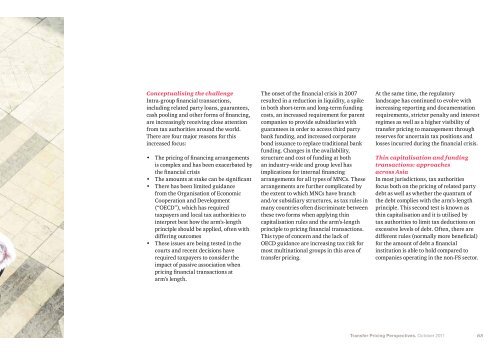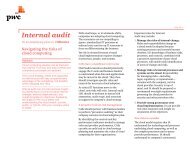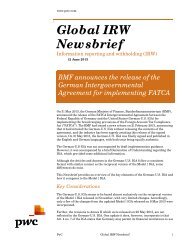Transfer pricing perspectives: Winds of Change - PwC
Transfer pricing perspectives: Winds of Change - PwC
Transfer pricing perspectives: Winds of Change - PwC
You also want an ePaper? Increase the reach of your titles
YUMPU automatically turns print PDFs into web optimized ePapers that Google loves.
Conceptualising the challengeIntra‐group financial transactions,including related party loans, guarantees,cash pooling and other forms <strong>of</strong> financing,are increasingly receiving close attentionfrom tax authorities around the world.There are four major reasons for thisincreased focus:• The <strong>pricing</strong> <strong>of</strong> financing arrangementsis complex and has been exacerbated bythe financial crisis• The amounts at stake can be significant• There has been limited guidancefrom the Organisation <strong>of</strong> EconomicCooperation and Development(“OECD”), which has requiredtaxpayers and local tax authorities tointerpret best how the arm’s-lengthprinciple should be applied, <strong>of</strong>ten withdiffering outcomes• These issues are being tested in thecourts and recent decisions haverequired taxpayers to consider theimpact <strong>of</strong> passive association when<strong>pricing</strong> financial transactions atarm’s length.The onset <strong>of</strong> the financial crisis in 2007resulted in a reduction in liquidity, a spikein both short-term and long-term fundingcosts, an increased requirement for parentcompanies to provide subsidiaries withguarantees in order to access third partybank funding, and increased corporatebond issuance to replace traditional bankfunding. <strong>Change</strong>s in the availability,structure and cost <strong>of</strong> funding at bothan industry-wide and group level hasimplications for internal financingarrangements for all types <strong>of</strong> MNCs. Thesearrangements are further complicated bythe extent to which MNCs have branchand/or subsidiary structures, as tax rules inmany countries <strong>of</strong>ten discriminate betweenthese two forms when applying thincapitalisation rules and the arm’s-lengthprinciple to <strong>pricing</strong> financial transactions.This type <strong>of</strong> concern and the lack <strong>of</strong>OECD guidance are increasing tax risk formost multinational groups in this area <strong>of</strong>transfer <strong>pricing</strong>.At the same time, the regulatorylandscape has continued to evolve withincreasing reporting and documentationrequirements, stricter penalty and interestregimes as well as a higher visibility <strong>of</strong>transfer <strong>pricing</strong> to management throughreserves for uncertain tax positions andlosses incurred during the financial crisis.Thin capitalisation and fundingtransactions: approachesacross AsiaIn most jurisdictions, tax authoritiesfocus both on the <strong>pricing</strong> <strong>of</strong> related partydebt as well as whether the quantum <strong>of</strong>the debt complies with the arm’s-lengthprinciple. This second test is known asthin capitalisation and it is utilised bytax authorities to limit tax deductions onexcessive levels <strong>of</strong> debt. Often, there aredifferent rules (normally more beneficial)for the amount <strong>of</strong> debt a financialinstitution is able to hold compared tocompanies operating in the non‐FS sector.<strong>Transfer</strong> Pricing Perspectives. October 201165
















